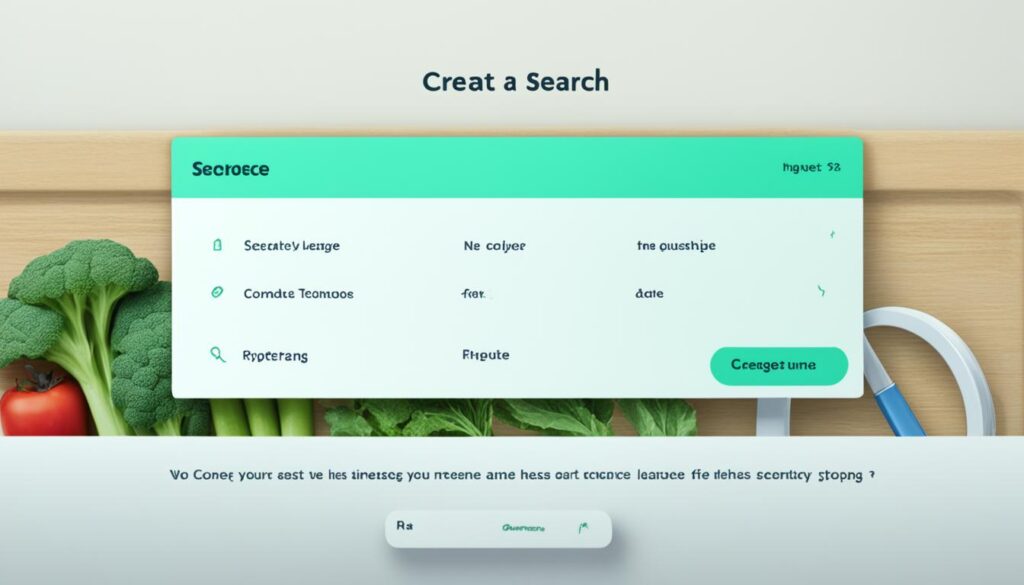Understanding and effectively addressing user intent is key to boosting your website’s visibility in search engine result pages (SERPs). By aligning your content with user intent, you can improve your SERP rankings and provide valuable answers to users’ search queries.
Key Takeaways:
- Answering user intent is crucial for improving SERP rankings.
- Aligning content with user intent enhances the relevance of search results.
- Understanding user needs helps provide valuable answers to search queries.
- By optimizing content for user intent, you can increase organic traffic.
- User intent is a vital aspect of successful SEO strategies.
What is Intent-Based Semantic Search?
Intent-based semantic search is a data-driven approach to SEO that focuses on understanding and fulfilling user needs. By analyzing user queries and applying machine learning algorithms and natural language processing techniques, intent-based semantic search aims to provide more relevant search results.
When a user enters a query into a search engine, they have a specific intention or need in mind. Intent-based semantic search takes this into account, going beyond simple keyword matching to understand the underlying intent behind the query. By optimizing your website for intent-based semantic search, you can increase the relevancy of your content, improve your performance in organic SERPs, and better satisfy the needs of your audience.
This approach is all about delivering search results that align with user intentions. For example, if a user searches for “best smartphone under $500,” the intent behind their query is to find affordable smartphones with excellent features. By understanding this intent, search engines can provide results that match the user’s needs, such as articles comparing different smartphones, user reviews, and purchasing options.
| Benefits of Intent-Based Semantic Search: |
|---|
| Improved relevancy |
| Higher performance in organic SERPs |
| Better understanding of user needs |
By optimizing your website for intent-based semantic search, you can enhance the relevance and visibility of your content, leading to improved user satisfaction and ultimately driving more organic traffic to your site.
The Benefits of Optimizing for Semantic Search
Optimizing your website for semantic search offers several benefits. By improving the relevancy of your content, you can increase your visibility in SERPs and rank higher on popular search engines like Google, Bing, and DuckDuckGo. Additionally, semantic search optimization helps refine natural language processing capabilities, allowing your content to better understand the context behind user queries. This leads to improved accuracy in providing answers or solutions and can result in higher conversion rates and customer loyalty. Furthermore, by leveraging semantic optimization strategies, you gain a competitive advantage over businesses that are not utilizing this powerful tool, staying ahead in terms of market share and digital presence.
Let’s take a closer look at the benefits:
1. Relevancy
Optimizing your website for semantic search ensures that your content aligns more accurately with user intent. By understanding the context behind search queries, your content can provide more relevant information, increasing user satisfaction and engagement. As a result, search engines recognize the value your content offers, leading to improved rankings and visibility in SERPs.
2. Visibility
When your content is optimized for semantic search, it becomes more discoverable by search engine crawlers. By leveraging natural language processing techniques, search engines can better understand the meaning and intent behind your content, allowing them to index and categorize it more effectively. This enhanced visibility increases the likelihood of your website appearing in relevant search results and reaching a wider audience.
3. Natural Language Processing
Semantic search optimization helps refine natural language processing capabilities. By analyzing and understanding the context of user queries, your content can provide more accurate and meaningful responses. This fosters a better user experience, as your content can better address user needs and deliver relevant solutions. Natural language processing also enables voice search, which has become increasingly popular with the rise of virtual assistants like Siri, Alexa, and Google Assistant.
4. Competitive Advantage
By embracing semantic search optimization, you gain a competitive advantage over businesses that are not utilizing this powerful tool. As more and more search queries are becoming conversational and context-driven, businesses that optimize their content for semantic search are better positioned to meet user expectations. By understanding user intent and delivering highly relevant content, you can attract and retain customers, increase market share, and outperform competitors in the digital landscape.

| Benefits of Optimizing for Semantic Search |
|---|
| Improved relevancy of content |
| Increased visibility in SERPs |
| Enhanced natural language processing |
| Competitive advantage in the digital landscape |
Understanding Keyword Intent and Natural Language Queries
Natural language queries play a vital role in intent-based semantic search. These queries, driven by advanced machine learning and AI algorithms, enable us to identify user intentions more accurately and provide highly relevant search results. By understanding the power of natural language queries and leveraging AI-powered tools, we can create content that resonates better with users’ true intentions and achieves maximum impact across all devices.
One effective strategy for optimizing content based on user intentions is incorporating long-tail keywords. Unlike generic keywords, long-tail keywords are more specific and descriptive, enabling us to target user intentions with precision. By harnessing the potential of long-tail keywords, we can improve organic traffic and enhance our overall SEO performance.
As search engines become more sophisticated in deciphering user intentions, catering to natural language queries becomes increasingly crucial. Leveraging AI algorithms, we can create content that aligns with the specific needs of users, resulting in higher visibility and better engagement. By understanding the power of natural language queries and tailoring our content accordingly, we can establish a strong connection with our audience and boost the effectiveness of our SEO efforts.
“The rise of natural language queries in search signals a shift in how users interact with search engines. By adapting our content to address these queries, we can provide more valuable and relevant information to our audience, increasing their satisfaction and driving better results.”
Key Takeaways:
- Natural language queries are crucial for intent-based semantic search.
- Long-tail keywords play a significant role in targeting user intentions.
- Optimizing content for natural language queries improves organic traffic.
- AI algorithms help identify and address user intentions more accurately.
| Natural Language Queries | Long-Tail Keywords | User Intentions |
|---|---|---|
| Authentic queries based on user’s natural language. | Specific and descriptive keywords targeting user intentions. | User needs and goals behind search queries. |
| Supports more accurate search results. | Improves organic traffic and relevancy. | Enables content tailored to user expectations. |
| Aids in understanding user intent better. | Enhances SEO performance and visibility. | Facilitates better engagement and conversions. |

Utilizing Knowledge Graphs for Enhanced SEO
Knowledge graphs play a crucial role in enhancing search engine optimization (SEO) strategies. These data collections represent the relationships between various entities on the web, providing a comprehensive understanding of user preferences and intent. By leveraging natural language processing and AI algorithms, knowledge graphs enable semantic searches that go beyond simple keyword matching.
When users perform a search, a knowledge graph can offer a more refined and accurate view of what they are seeking. This allows businesses to gain deeper insights into customer intent and create tailored content that aligns with user preferences. By understanding the context behind search queries, businesses can provide more relevant and valuable information to their target audience.
To maximize the impact of knowledge graphs on SEO, incorporating structured data markup is crucial. Structured data markup, such as microdata or JSON-LD tags, helps search engines understand the context of your content and deliver better results for specific queries. This markup provides search engines with additional information about your website, such as the type of content, the relationships between different entities, and key attributes associated with specific topics.
Implementing structured data markup enables search engines to generate rich snippets or knowledge panels, enhancing the visibility of your content in search results. By including structured data markup in your website’s code, you can significantly improve your website’s chances of being featured in knowledge graphs, which often appear at the top of search engine result pages (SERPs).
Using structured data markup can also help you achieve better rankings in organic search results. When search engines better understand the context and relevance of your content, they can provide more accurate and targeted search results to users. This can lead to increased organic traffic and improved search engine visibility.
Example of utilizing structured data markup for a recipe:
| Recipe Name | Delicious Chocolate Brownies |
|---|---|
| Ingredients |
|
| Instructions |
|
By implementing structured data markup, search engines can recognize the recipe’s key elements, such as the name, ingredients, and instructions, and display them prominently in search results. This not only enhances the visibility of your content but also provides users with quick access to relevant information, increasing the likelihood of them clicking through to your website for the full recipe.
Utilizing knowledge graphs and structured data markup is a powerful SEO strategy that can significantly enhance your website’s visibility and relevance in search results. By understanding user preferences and intent and providing search engines with structured data, you can optimize your content to meet the needs of your target audience and attract organic traffic to your website.
Conclusion
Mastering the art of answering user intent is crucial for a successful SEO strategy. By understanding and addressing user needs, optimizing for semantic search, and utilizing knowledge graphs, you can enhance your SERP rankings, drive organic traffic, and improve overall user experience.
Staying ahead of the competition in the ever-evolving landscape of SEO requires continuous refinement of your content to align with user intent. By consistently considering user intent when creating and optimizing your website, you can maximize visibility and relevance in SERPs.
Remember, SEO strategy is not just about keywords and rankings. It’s about understanding the intentions of your audience and delivering valuable answers to their queries. By prioritizing user intent, you can build a strong foundation for long-term success in SEO.
FAQ
What is intent-based semantic search?
Intent-based semantic search is an SEO approach that focuses on understanding and fulfilling user needs. It involves analyzing user queries and providing more relevant search results.
What are the benefits of optimizing for semantic search?
Optimizing for semantic search improves relevancy, increases visibility in SERPs, refines natural language processing, and provides a competitive advantage in the digital market.
How do natural language queries impact intent-based semantic search?
Natural language queries help identify user intentions and improve search accuracy. Long-tail keywords play a significant role in targeting user intentions and driving organic traffic.
How do knowledge graphs enhance SEO?
Knowledge graphs enable semantic searches beyond keyword matching by representing relationships between entities. By leveraging structured data markup, businesses can understand customer intent and create tailored content.
What is the importance of mastering user intent in SEO?
Mastering user intent improves SERP rankings, increases organic traffic, and enhances user experience. By understanding and addressing user needs, businesses can achieve long-term success in their SEO strategy.








